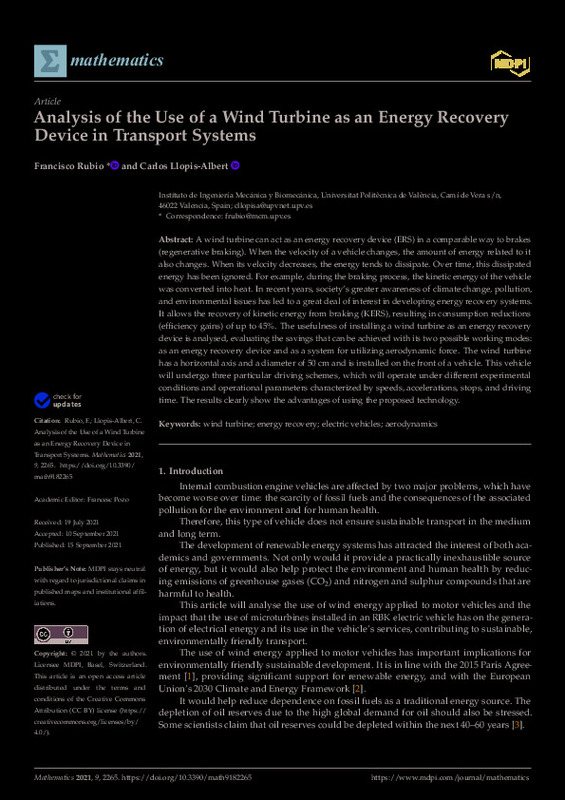JavaScript is disabled for your browser. Some features of this site may not work without it.
Buscar en RiuNet
Listar
Mi cuenta
Estadísticas
Ayuda RiuNet
Admin. UPV
Analysis of the Use of a Wind Turbine as an Energy Recovery Device in Transport Systems
Mostrar el registro sencillo del ítem
Ficheros en el ítem
| dc.contributor.author | Rubio Montoya, Francisco José
|
es_ES |
| dc.contributor.author | Llopis-Albert, Carlos
|
es_ES |
| dc.date.accessioned | 2022-09-22T18:03:20Z | |
| dc.date.available | 2022-09-22T18:03:20Z | |
| dc.date.issued | 2021-09 | es_ES |
| dc.identifier.uri | http://hdl.handle.net/10251/186468 | |
| dc.description.abstract | [EN] A wind turbine can act as an energy recovery device (ERS) in a comparable way to brakes (regenerative braking). When the velocity of a vehicle changes, the amount of energy related to it also changes. When its velocity decreases, the energy tends to dissipate. Over time, this dissipated energy has been ignored. For example, during the braking process, the kinetic energy of the vehicle was converted into heat. In recent years, society¿s greater awareness of climate change, pollution, and environmental issues has led to a great deal of interest in developing energy recovery systems. It allows the recovery of kinetic energy from braking (KERS), resulting in consumption reductions (efficiency gains) of up to 45%. The usefulness of installing a wind turbine as an energy recovery device is analysed, evaluating the savings that can be achieved with its two possible working modes: as an energy recovery device and as a system for utilizing aerodynamic force. The wind turbine has a horizontal axis and a diameter of 50 cm and is installed on the front of a vehicle. This vehicle will undergo three particular driving schemes, which will operate under different experimental conditions and operational parameters characterized by speeds, accelerations, stops, and driving time. The results clearly show the advantages of using the proposed technology. | es_ES |
| dc.language | Inglés | es_ES |
| dc.publisher | MDPI AG | es_ES |
| dc.relation.ispartof | Mathematics | es_ES |
| dc.rights | Reconocimiento (by) | es_ES |
| dc.subject | Wind turbine | es_ES |
| dc.subject | Energy recovery | es_ES |
| dc.subject | Electric vehicles | es_ES |
| dc.subject | Aerodynamics | es_ES |
| dc.subject.classification | INGENIERIA MECANICA | es_ES |
| dc.title | Analysis of the Use of a Wind Turbine as an Energy Recovery Device in Transport Systems | es_ES |
| dc.type | Artículo | es_ES |
| dc.identifier.doi | 10.3390/math9182265 | es_ES |
| dc.rights.accessRights | Abierto | es_ES |
| dc.contributor.affiliation | Universitat Politècnica de València. Departamento de Ingeniería Mecánica y de Materiales - Departament d'Enginyeria Mecànica i de Materials | es_ES |
| dc.description.bibliographicCitation | Rubio Montoya, FJ.; Llopis-Albert, C. (2021). Analysis of the Use of a Wind Turbine as an Energy Recovery Device in Transport Systems. Mathematics. 9(18):1-15. https://doi.org/10.3390/math9182265 | es_ES |
| dc.description.accrualMethod | S | es_ES |
| dc.relation.publisherversion | https://doi.org/10.3390/math9182265 | es_ES |
| dc.description.upvformatpinicio | 1 | es_ES |
| dc.description.upvformatpfin | 15 | es_ES |
| dc.type.version | info:eu-repo/semantics/publishedVersion | es_ES |
| dc.description.volume | 9 | es_ES |
| dc.description.issue | 18 | es_ES |
| dc.identifier.eissn | 2227-7390 | es_ES |
| dc.relation.pasarela | S\445702 | es_ES |








